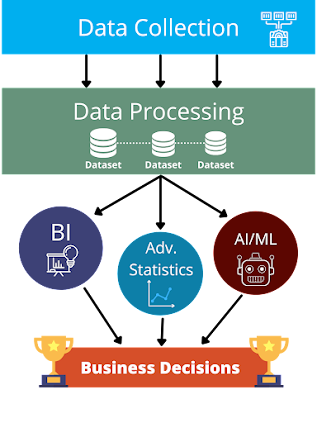Throughout the past several years, the world was inundated with different interrelated terms such as “data”, “data analysis”, “data analytics”, “business intelligence”, “predictive analytics, and many more. This has caused a lot of confusion over what each of them means and what it is for. This confusion is problematic among many professionals including HR staff, which often leads to misleading job positions.
In this article, we will try to tackle this dilemma by briefly tracing the history of data science and how it came to be the way we know it today. As we go, we will clarify the most critical terms the contributed to this mix-up. This shall enable you to differentiate between these terms more easily.
So, let us begin.
It all began with statistics
To a far extent, yes. Statistics can be considered the cornerstone of what we now know as Data Science. And as we all know, in a nutshell, statistics is the discipline concerned with all aspects related to data. Therefore, a statistician is someone who is responsible for collecting data, creating and maintaining datasets, and then utilizing different statistical methods to interpret them in a meaningful way.
At this basic level, the statistician’s job was going smoothly. However, as the amount of data produced began to increase, along with the substantial improvement in information technology, things became more challenging. In addition to his/her previous responsibilities, the statistician is now required to derive different useful patterns from data. This created a need for a more complex approach, which leads us to the next stage.
Mining the data
To help the statistician in his new role, a new field was conceived known as Data Mining. Within this new field, our fellow statistician possessed a whole new set of tools that enabled them to work better with large sets of data. S/he is now more capable of performing analysis, finding patterns and correlations, detecting anomalies, and even predicting certain outcomes, and s/he can do it much faster than before. To keep things simple, it is safe to say that these tasks constitute the core of the concept of Data Mining.
But hold the phone, did we just mention “predicting outcomes”? Yes! And this brings us to the next stop in the evolution of Data Science. It is known as Predictive Analytics. More on this later on.
At this point, all the circumstances are set in place for the emergence of the next groundbreaking trend: Data Science!
The birth of the Data Scientist
At this point, the field of Data Science came up as an umbrella that encompasses all these aspects together. First, there’s the raw data gathered from different sources, still pristine and unprocessed. To keep things simple, it is safe to say that, from this point on, the data is processed and analyzed in 4 main ways: Business Intelligence (BI), Regular Statistical Methods, Artificial Intelligence, and Machine Learning. And these constitute the 4 main aspects of the field of Data Science.
Business Intelligence (BI)
After our datasets have been prepared and made ready for further processing, the BI systems’ primary task is to analyze them and produce useful reports, dashboards, and other metrics. Consequently, these metrics are much easier to study in order to extract business insights from the data.
In the real world, there’s a plethora of examples where BI plays a vital role. One such example is Inventory Management. The elaborate information presented by the BI tools allows the supply chain managers to set just the right amount of supply needed to cover current demand. This is very essential as it helps them avoid the perils of potential over- or under-supply. This can be based on, for example, previous market trends and can be combined with configurable business rules.
Regular Statistical Methods
In short, when talking about regular statistical methods, we mean 3 main types: regression methods, cluster methods, and factor analysis methods. We won’t go into them in detail, however, as this is out of the scope of this article’s main topic. There are plenty of online resources on these topics, however, and we may cover some of the relevant aspects of business statistics in a separate article.
What we will mention here though is one out of countless examples where they come in handy. This example is Sales Forecasting. Forecasting future sales trends is an integral part of every financial and business institution. Achieving higher sales and avoiding loss entails carefully studying spikes and drops in sales across certain time intervals. Based on this information, the system would generate more accurate predictions of future potential trends. The sales team will then use these predictions to develop adequate sales strategies and take the necessary steps to respond to anticipated market changes.
And yes, this is one typical example where predictive analytics, which was mentioned earlier, comes into play.
AI and Machine Learning (ML)
Because they are closely related, I chose to put Artificial Intelligence and Machine Learning together. In simple language, the basic idea behind AI and ML is to analyze data and predict future behavior in maximum possible accuracy, and in a very short time; that is, much faster than that of using regular statistical methods.
One great example where ML/AI can be essential is fraud detection in the financial sector. This is because machine learning systems can process huge amounts of past legitimate transactions that are fed to them by the development team. Based on that, they would develop accurate patterns according to which they can single out those suspicious transactions and red flag them in real-time.
Wrapping up…
This was, in a nutshell, a brief history of how the field of Data Science evolved into what we know today. In simple language, it is safe to say that it was born from the marriage between Math (especially Statistics & Probability) and Computer Science.
Finally, as we have discussed above, the applications of Data Science are quite endless. Aside from the examples we mentioned, Data Science and play a vital role in virtually anything, from Sales and Marketing and all the way to Pharmaceutical sciences and more!
Quite amazing, isn’t it?
Check out ESKADENIA’s powerful Business Intelligence software system, ESKA® Analytics.



No comments:
Post a Comment